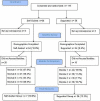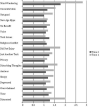Online Mindfulness Intervention for Inflammatory Bowel Disease: Adherence and Efficacy
- PMID: 35401288
- PMCID: PMC8987583
- DOI: 10.3389/fpsyg.2021.709899
Online Mindfulness Intervention for Inflammatory Bowel Disease: Adherence and Efficacy
Abstract
The impact of stress and other psychological variables on Inflammatory Bowel Disease (IBD) prognosis, treatment response, and functional level is well-established; however, typical IBD treatment focuses on the physiological pathology of the disease and neglects complementary stress-reducing interventions. Recent pilot studies report the benefits of mindfulness-based interventions (MBIs) in people living with IBD, but are limited by small sample sizes. Recruitment challenges to in-person studies may be in part due to the difficulty IBD patients often have adhering to fixed schedules and travel as a result of IBD symptoms such as pain, fatigue, and incontinence. The current study aimed to address this barrier by offering participants access to online mindfulness training, allowing individuals to engage with intervention materials to fit their own schedule. Online mindfulness programs have gained popularity in recent years, as they increase access and flexibility and decrease cost to the user; however, the dropout rate tends to be high. The current study compared the rate of adherence and efficacy of mindfulness training as a function of level of support: self-guided versus supported. Analysis revealed no significant difference in the benefits received between participants in the two groups; however, a significant difference group (χ2 = 15.75; p = 0.000, r = 0.38) was found in terms of rate of completion, with 44.1% of the supportive group completing the protocol compared to 11.7% of the self-guided. Common challenges to meditation were measured, but did not significantly predict adherence to the intervention, and experience of these challenges did not significantly change (increase or decrease) over the duration of the study. Implications of the current research, future directions for the use of MBI for IBD patients, and a discussion of methodological considerations are provided.
Keywords: Crohn’s disease; Inflammatory Bowel Disease; meditation; mindfulness; online intervention; ulcerative colitis.
Copyright © 2022 Forbes and Johnson.
Conflict of interest statement
The authors declare that the research was conducted in the absence of any commercial or financial relationships that could be construed as a potential conflict of interest.
Figures
References
-
- Ball E., Newton S., Rohricht F., Steed L., Birch J., Dodds J., et al. (2020). mHealth: providing a mindfulness app for women with chronic pelvic pain in gynaecology outpatient clinics: qualitative data analysis of user experience and lessons learnt. BMJ Open 10:e030711. 10.1136/bmjopen-2019-030711 - DOI - PMC - PubMed
-
- Bays J. (2012). Mouthfuls of Mindfulness. Palouse mindfulness.com.
-
- Beck A. T., Epstein N., Brown G., Steer R. A. (1988). An inventory for measuring clinical anxiety: psychometric properties. J. Consult. Clin. Psychol. 56 893–897. - PubMed
-
- Beck A. T., Steer R. A. (1991). Relationship between the Beck Anxiety Inventory and the Hamilton anxiety rating scale with anxious outpatients. J. Anxiety Dis. 5 213–223.
LinkOut - more resources
Full Text Sources





